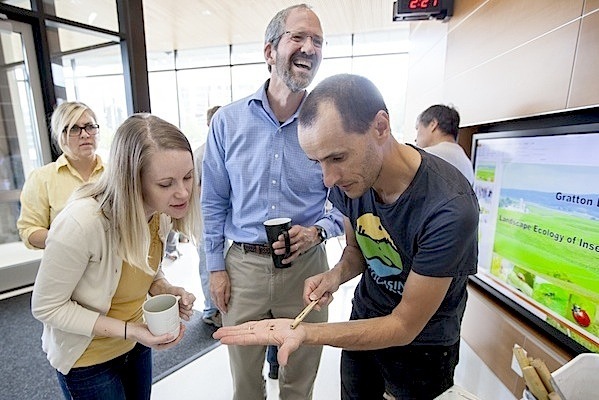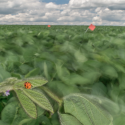Teatime becoming an institution at institutes

Entomologist Claudio Gratton, right, describes bee-capturing methods used to survey insect pollinators living near fields of switchgrass to, from left, Lacey Millard, Falicia Hines and John Greenler at a recent Wisconsin Energy Institute teatime.
For David Krakauer, a cup of tea has long been as much a part of the research process as beakers, computers and lab benches.
“All the places I’ve been — Oxford, the Institute for Advanced Study at Princeton, the Santa Fe Institute — have had this institution, a daily tea,” says Krakauer, director of the Wisconsin Institute for Discovery. “Immensely influential people like Francis Crick insisted it be built into the Salk Institute because it was done at the Medical Research Council at Cambridge where he was a student, and where [molecular biologist] Max Perutz attributed their Nobel Prize success to tea.”
The bar for success at the Wisconsin Institutes for Discovery may not be as high as double-digit Nobel count Perutz’s colleagues have accrued, but Krakauer and Morgridge Institute for Research CEO Brad Schwartz have made sure the daily rhythm of life in the Discovery Building’s upper floors includes a 3 p.m. teatime.
Scientific and gastronomic cultural history aside, “Tea@3” (and a more structured weekly brown-bag lunch series) plays an important role in the institutes’ mission. There is an expectation that the many labs at work in the building and affiliated researchers — about 500 people, all told — will be well represented around the snack table now and then, contact that improves the chances for collaboration and exchange of ideas.
“Communication is so important, but there are not many opportunities to get together to talk about our questions and problems in a nontechnical way,” Krakauer says. “Our feeling is that collaborations start informally, but the opportunities for informal meeting are diminishing.”
The unstructured nature of Discovery’s tea provides a mixing vessel for people from different strata of the academic community — from graduate students up to senior faculty and back — and a level of familiarity that breeds a different sort of interaction.
“If you’re seeing people on a daily basis, there’s only so many times you can ask, ‘How’s your research going?’” says Chris Ellison, a postdoctoral researcher in the institute’s Center for Complexity and Collective Computation. “At tea, it’s more common for me to have a general intellectual academic discussion rather than discussions about specific topics.”
If a more in-depth discussion seems necessary, it gets scheduled for an office visit, Ellison says, not over the simple spread of bagged tea and coffee, pretzels and Nutella or veggies provided at teatime.
“Getting into the nitty-gritty in the middle of tea can be kind of alienating for other people,” Ellison says.
That is illustrative of another benefit of teatime, according to Krakauer: by clearing up small tasks, it can be a significant time-saver.
The unstructured nature of Discovery’s tea provides a mixing vessel for people from different strata of the academic community — from graduate students up to senior faculty and back — and a level of familiarity that breeds a different sort of interaction.
“If I’m just standing around at tea time, I can answer 30-second questions immediately,” Krakauer says. “It’s very efficient.”
It’s one of entomology professor Claudio Gratton’s favorite things about teatime at the Wisconsin Energy Institute, which now hosts a teatime every Thursday at 2 p.m. in its first floor lounge.
“I always find myself thinking something like, ‘Oh, look — the IT guys are here. I need to talk to them about something really quick,’” Gratton says. “It’s usually something that wasn’t worth scheduling a meeting or making a phone call, and we can work it out right there by the cookies.”
The energy institute has taken a more structured approach to tea, according to the Falicia Hines, a university relations specialist who has added to the hot drinks and sweets by scheduling researchers from the institute and related labs around campus for show-and-tell exhibits every other week or so.
Gratton set up a display of bees and bee-trapping instruments recently to hip coworkers to his lab’s work with important pollinators living in and around fields planted with biofuel feedstock like switchgrass.
“One of the things that happens is people get their tea or coffee and re-congeal into their own lab groups,” Gratton says. “But there are so many different kinds of research in our building, I want to mix it up. I want to throw my stuff out there to people with different perspectives and hear them say, ‘Why do you do it this way with the bees? This is how we do it while we’re working with microbes.’”
“One of the things that happens is people get their tea or coffee and re-congeal into their own lab groups. But there are so many different kinds of research in our building, I want to mix it up.”
Claudio Gratton
Bees are a good spark for that interaction — “They’re sexy; they’re pretty,” Gratton says — but it doesn’t take sexy and pretty to make people talk.
There are games at Discovery’s tea, and WID Chief Communications Officer Marianne English tries to spark discussion with a board for “buzz” questions. How has technology made us smarter or dumber? What does hacking mean to you?
“Sometimes we’ll talk about the answers people have posted, and then you’re meeting people,” Ellison says. “Bananagrams is pretty good for that, too.”
There’s no good way to declare teatime a success, but Krakauer has no problem declaring it a necessity.
“Quantifying the benefit, I have a problem with that with science itself, much less teatime,” he says. “To me, the importance of this unstructured gathering time is self-evident, and I highly recommend it to every department on campus that they try it, too.”


